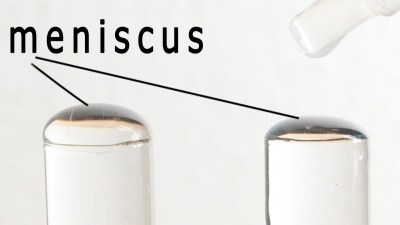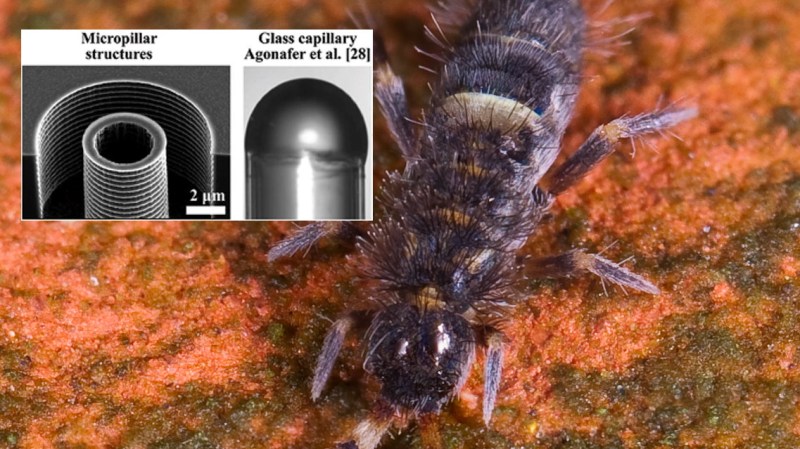“We want to put water right into your processor.” If that statement makes you sweat, that is good. Sweating is what we’re talking about, but it’s more involved than adding some water like a potted plant. Sweating works naturally by allowing liquid to evaporate, and that phase change is endothermic which is why it feels cool. Evaporative coolers that work in this way, also known as swamp coolers, haven’t been put into computers before because they are full of sloshy water. Researchers in South Korea and the United States of America have been working on an evaporative cooling system mimicking the way some insects keep themselves cool by breathing through their exoskeletons while living in damp soil.

Springtails are little bugs that have to keep the water and air separate, so they don’t drown in the wet dirt where they live. Mother Nature’s solution was for them to evolve to do this with columns that have sharp edges at the exit. Imagine you slowly add water to a test tube, it won’t spill as soon as you reach the top, it will form a dome. This is the meniscus. At a large scale, say a river dam, as soon as you get over the dam you would expect spillage, but at the test tube level you can see a curve. At the scale of the springtail, exuded water will form a globe and resist water pressure. That resistance to water pressure allows this type of water cooling to self-regulate. Those globes provide a lot of surface area, and as they evaporate, they allow more water to replenish the globe. Of course, excessive pressure will turn them into the smallest squirt guns.
We have invented a lot by copying Mother Nature. Velcro was inspired by burrs, and some of our most clever robots copy insects. We can also be jerks about it.
















I remember seeing a water cooled PC that used a miniature evaporative cooling tower.
That sounds like a bong cooler. They can produce useful cooling in low humidity climates but they’re also great for growing algae/molds and the evaporation will concentrate any minerals in the water. It would add an extra layer of complexity but I would definitely recommend using a heat exchanger so that the atmosphere-facing coolant is kept separate from the CPU/GPU-facing coolant.
I wonder how many hours such a system could function before salt/dirt/mineral deposits block the ends of the capillary tubes. I think even the purest distilled water would tend to pick up dissolved solids, and then leave them behind as it evaporated.
Distilled / RO water has total dissolved solids under 50mg/L so if you’re ‘picking up’ tds its because your system is rusting out. Which shouldn’t happen & by that stage the water has become conductive, affecting the ability for the cpu to function or the system is leaking causing other issues.
Otherwise it’ll take many hundreds of liters of water to affect the cooling system.
The purest water would pick up stuff, because it’s incredibly corrosive.
[…] it’s incredibly corrosive.
Uh, no. A popular myth. Ultra-pure water is no more “corrosive” than, say, any drinkable water, and a good deal LESS corrosive than pure, fresh rainwater (which is slightly acidic due to dissolved carbon dioxide absorbed from air).
People using ultrapure water take care to use special materials to transport it, not because the water is corrosive, but because most materials will leach out tiny amounts of ions that will contaminate it. Polyethylene was the pipe of choice when I was in that game years ago, but it was miserable to make joints: leaks were common.
Any CPU heatsink that has heatpipes (i.e., most of them, these days) ALREADY uses evaporative cooling. That’s how they WORK.
The source article mentions replacing water with non-conductive dielectric fluids, so potentially could move the evaporative surface right down to the silicon, instead of going through layers of packaging and copper, so that might be a win. (though pure enough water is a pretty fine dielectric itself)
Water has BY FAR the highest latent heat of evaporation of any other reasonable alternative, though. It might be tough to find a good replacement for it in this application.
True, except for the sealed part.
A liter an hour takes 600 Watts of heat. If the evaporation is not in a closed loop, even small amounts of cooling uses more water than is practical to carry along.
My dual cpu micro server uses 20w max. Equal to a small laptop, doubling that to 40w puts 600/40 at enough hours to tell you to get a life. ???? And we are told that WE don’t drink enough. This will remind you, and, you will finally have handy distilled water on hand to top off your car and motorcycle batteries in a more timely fashion. This also doesn’t have to be the only cooling, but supplimental. People might pull a “cover” off a laptop to point at the sun for solar elec boost. The farside if this could be the evaporation pad or tower… even a heat exchanger so nothing evaporates. (May cool the solar array also???) Peltiers are not doing the job? Heck, my 20 watter doesn’t even have a fan.
>”enough hours to tell you to get a life.”
It’s about 70 ml an hour. In other words, running the device for 24 hours requires 1.7 liters of water. That’s a thirsty machine.
The point is, small devices that use little enough power to begin with don’t need evaporative cooling. Large devices that do use so much water that it’s pointless.
BillSF9c: The original authors mention the application is for power densities in excess of a kilowatt per square cm. Your little server need not apply.
Any sensible system that uses liquid/vapor cooling will have a closed loop of coolant. Not only for purity requirements, but also expense. Any non-trivial cooling system will require a *lot* of liquid flow. A not-very-large system I worked with for a few years had a 50 kW chiller: closed-loop of course. When the chiller plant needed to be serviced, we ran a backup open-loop (through a heat exchanger), using city water for cooling, and just dumping slightly warmer water down the drain: it used about $1000 per day of water.
I once designed a computer which submerged all components plus the evap coil of a window box air conditioner in a tank of mineral oil. It sure got chilly, but mineral oil is gross as hell. Never will I recommended cleaning liquid laxative out of a pcie slot to upgrade a gpu. Not worth it.
Even more easy make a clay computer add some water and you have the “Botijo Computer”
http://quim.iqi.etsii.upm.es/botijo.pdf
https://en.wikipedia.org/wiki/Botijo
We don’t “invent” by copying mother nature: we DISCOVER.
We discover, but then go on and use it in ways nature doesn’t.